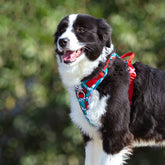Understanding Canine Heatstroke: Essential Safety Tips for Dog Owners
Table of Contents
- Key Highlights
- Introduction
- The Hidden Dangers: Recognizing Heatstroke Symptoms
- Preventative Measures: Keeping Dogs Cool
- Immediate Actions: Responding to Signs of Heatstroke
- The Importance of Veterinary Care
- Frequently Encountered Misconceptions
- Strategies for Dog Owners to Prevent Heatstroke Year-Round
- Conclusion: Ensuring a Safe and Happy Summer for Dogs
Key Highlights
- A "smiling" dog may actually be a sign of overheating, with panting potentially indicating heatstroke.
- Owners must recognize early signs of heat-related distress, especially in vulnerable breeds.
- Immediate action, including cooling strategies and contacting a veterinarian, is crucial for a dog's survival in heat.
Introduction
As summer temperatures rise, the safety and well-being of our canine companions become a paramount concern. While many dogs enjoy playing outdoors, an increase in heat can pose serious health risks that every dog owner should be aware of. Contrary to popular belief, a dog's panting—which may appear as a playful grin—can actually signal overheating and the potential for heatstroke. Understanding the warning signs and knowing how to respond effectively can mean the difference between life and death for a beloved pet.
Recent warnings from Dogs Trust Newbury highlight the critical need for pet owners to remain vigilant during hotter months. With senior veterinary surgeon Victoria Henry sounding the alarm, the message is clear: dogs are at risk, and it is the responsibility of their owners to ensure their safety. The inability of dogs to regulate their body temperature as efficiently as humans means that vigilance during high temperatures is crucial. This article delves into the signs of heatstroke, risk factors, preventative measures, and appropriate first aid responses that every dog owner must know.
The Hidden Dangers: Recognizing Heatstroke Symptoms
Heatstroke in dogs can develop quickly, so it is essential for owners to be knowledgeable about the signs. Indicators often mistaken for happiness may include excessive panting and an open-mouthed expression, but these behaviors can signify distress and overheating.
Common Signs of Heatstroke
- Excessive Panting: While all dogs pant, excessive and rapid panting is a clear signal that a dog may be overheated.
- Drooling: Heavy drooling is a typical symptom of heat distress. Observe your dog for sudden changes in salivation.
- Lethargy: A dog that seems unusually tired or uninterested in usual activities may be struggling to cope with the heat.
- Drowsiness and Weakness: Being lethargic and having difficulty keeping balance can indicate severe overheating.
- Gastrointestinal Issues: Vomiting and diarrhea are serious signs that should not be overlooked.
- Collapse: In extreme cases, a dog may collapse or show signs of disorientation, necessitating immediate attention.
Vulnerable Breeds at Higher Risk
Certain breeds are more susceptible to heat-related issues, primarily due to their physical characteristics and health conditions. Flat-faced breeds, such as English Bulldogs, Pugs, and French Bulldogs, often have difficulties in breathing, making them particularly vulnerable to heat stress. Similarly, older dogs, overweight dogs, and those with pre-existing conditions, including respiratory or cardiac issues, are at a greater risk.
Preventative Measures: Keeping Dogs Cool
Prevention is the first line of defense against heatstroke. Here are key strategies for ensuring your dog's safety during heat waves:
Hydration is Key
Have fresh, cool water available at all times. Encourage your dog to drink regularly, especially after outdoor play. Consider using a water bowl that allows easy access, or carry water on outings.
Shade and Rest
Ensure that your pet has access to shaded areas, both at home and while out. If you're planning outdoor activities, schedule walks in the early morning or late in the evening when temperatures are cooler, and allow for rest periods in the shade.
Grooming Considerations
Appropriate grooming can prevent overheating. While it may be tempting to shave your dog in warmer months, many breeds benefit from their natural coat for temperature regulation. Regular brushing helps remove excess fur and can keep your pet cooler.
Avoid Hot Surfaces
Asphalt and sand can reach extreme temperatures, burning a dog’s pads. Before walking your dog, test the surface with your hand; if it’s too hot for you, it’s too hot for them.
Immediate Actions: Responding to Signs of Heatstroke
If you suspect your dog is suffering from heatstroke, every second counts. Immediate action is crucial in mitigating the risk of serious health complications.
Step-by-Step Cooling Techniques
-
Stop All Activities: Immediately cease any exercise or play.
-
Move to Cool Area: Get your dog into a shaded or air-conditioned space as quickly as possible.
-
Initiate Cooling: Depending on the severity:
- For a healthy dog, consider immersing them in cool water, or use hoses or buckets to gently spray them down.
- For older dogs or those with health conditions, use room-temperature water, fan them with airflow, and avoid rapid cooling methods.
- Place ice wrapped in a towel against the groin and armpits to reduce body temperature strategically.
-
Monitor Body Temperature: Use a rectal thermometer for an accurate read. A normal temperature for dogs ranges from 101 to 102.5 degrees Fahrenheit. If your dog’s temperature exceeds 103 degrees, it is critical to cool them down.
-
Watch for Shivering: If your dog starts shivering, this is a sign that they are becoming too cold. Immediately stop cooling measures to prevent hypothermia.
-
Contact a Veterinarian: Regardless of how your dog appears post-cooling, contact a vet immediately. Heatstroke can cause internal damage, and professional veterinary assistance is necessary for recovery.
The Importance of Veterinary Care
Even if your dog seems to recover from an episode of overheating, it’s vital to seek veterinary care. The veterinarian will assess for any long-term effects of heatstroke, which can include organ damage. Ongoing monitoring may also be needed to ensure your dog does not suffer from complications.
Frequently Encountered Misconceptions
Many dog owners may be unaware of common heatstroke myths that could jeopardize their pet's health. Here are a few truths that dispel dangerous misconceptions:
Myth 1: Dogs Only Overheat in Extreme Heat
While it’s true that higher temperatures increase the likelihood of overheating, dogs can suffer from heat-related illnesses even in seemingly moderate conditions. Awareness of humidity levels is just as important, as humid air can prevent dogs from cooling via evaporation.
Myth 2: Short Walks Are Always Safe
Even short walks can be hazardous during warm weather. Owners should always assess their dog’s individual tolerance and the day’s temperature before heading out.
Myth 3: Cooling vests are a Guarantee of Safety
Cooling vests can reduce a dog's body temperature but should not be relied upon as the sole method of cooling. Regular breaks and other cooling techniques must accompany the use of these products.
Strategies for Dog Owners to Prevent Heatstroke Year-Round
While summertime poses increased risks, being proactive all year round can help safeguard against heat-related conditions:
Education and Awareness
Stay informed about your dog’s specific needs and risks based on breed, age, and health status. The more you know, the better equipped you will be to prevent emergencies.
Building a Safety Plan
Have a plan in place for emergency responses. This should include contact numbers for your veterinarian and the nearest animal hospital, as well as an action plan to execute if you suspect heatstroke.
Training and Socialization
Ensuring your dog is trained to respond to commands can significantly aid in managing behavior during heat. Training is valuable, especially during stressful situations, allowing you to maintain control.
Community Engagement
Engage with fellow dog owners and communities that emphasize responsible ownership. Share knowledge, tips, and community resources to foster a safer environment for all dogs.
Conclusion: Ensuring a Safe and Happy Summer for Dogs
With the right knowledge and understanding, dog owners can significantly mitigate the risks associated with heat exposure. By being vigilant in recognizing the signs of heatstroke, taking strategic preventive measures, and knowing how to respond appropriately in emergencies, we can provide our beloved pets with a safe and enjoyable summer.
As temperatures rise, so does the responsibility of dog ownership. It's not only about ensuring their happiness and exercise; it’s about making informed decisions that prioritize their health and safety. Together, we can create an environment where our canine companions thrive, even on the hottest days.
FAQ
1. What should I do if my dog gets heatstroke?
- Immediately stop all activity, move them to a cool, shaded area, and begin cooling methods. Contact a veterinarian as soon as possible.
2. Can certain breeds handle heat better than others?
- No, all dogs can suffer from heatstroke, but certain breeds—especially flat-faced ones—are at higher risk.
3. How can I prevent my dog from overheating?
- Ensure they remain hydrated, have access to shade, and avoid strenuous activities during peak heat.
4. Are there specific signs that indicate heatstroke?
- Symptoms include excessive panting, drooling, lethargy, weakness, vomiting, or collapse.
5. Should I shave my dog in summer?
- Avoid shaving unless necessary, as a dog's coat can protect them from overheating. Regular brushing is often more beneficial.





